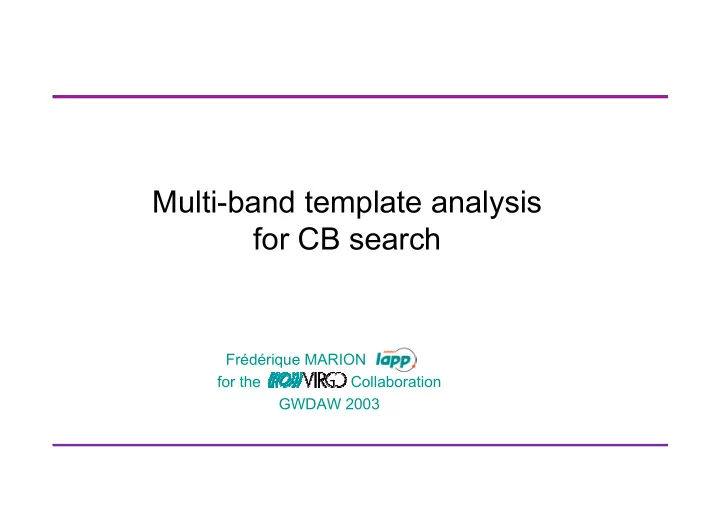

Multi-band template analysis for CB search Frédérique MARION for the Collaboration GWDAW 2003
The Multi-Band Template Analysis � Alternate matched filtering technique � designed to release stress on computing resources for CB search � Split analysis in a few (2 - 3) frequency bands � coherent band combination provides result for full (virtual) template � for each band, number of templates and FFT size both reduced � CPU and storage requirements reduced » up to factors 100 for CPU and 500 for storage – for 3 bands, low minimal mass, low minimal frequency � Built-in hierarchical search � each band can be analyzed independently � coherent combination grants unchanged SNR 2 GWDAW 2003
MBTA today � Prototype algorithm implementation ~ complete � filtering machinery � search algorithm � event clustering � Interface to template computation and placement library � inspiral library provides several template generators � grid generation currently based on smallest elliptical isomatch contour » plan to try true isomatch contours � VIRGO CITF E4 data � simple test analysis in realistic environment (Moriond 2003) � Mock Data Challenges � validation process in well defined conditions 3 GWDAW 2003
CITF E4 data test analysis (I) � ~ 10 hours of quiet data � ITF & OMC locked � Monitor horizon distance for a few masses � evidence bad periods 4 GWDAW 2003
CITF E4 data test analysis (II) � Single template search � (3 M � , 3 M � ) � [50 Hz - 2 kHz] � Probe ITF noise level � quiet enough after simple vetoes � Compare 1 & 2 bands analyses � consistency checked � SNR correlation fairly good 5 GWDAW 2003
Validation through MDCs � 3 mock data challenges held in VIRGO in 2003 � data generated with SIESTA » based on CITF E4 spectrum (sensitivity mostly above 80 Hz) – non-stationarities & unlocked segments introduced in MDC III » simulated events from inspiral – various models, various SNR � probe integration of software pieces needed for CB analysis � probe algorithm performances » detection efficiency, SNR recovery » robustness to data flaws 6 GWDAW 2003
Detection efficiency � Event selection � event clustering allows to rely on SNR cut � regular noise fallout allows detection of events with SNR > ~7 � Selection efficiency � typically at 95% level for SNR ≥ 7 � many studies to understand SNR loss budget » grid » template generator » lower and upper analysis frequency 7 GWDAW 2003
2 bands vs 1 band � Systematic comparisons � same efficiency � same purity � good SNR correlation SNR 2 bands = ± 0 . 99 0 . 07 SNR 1 band � Increased computing efficiency � limited due to narrow-band spectrum used in MDCs so far 8 GWDAW 2003
CPU gain estimation � Measure gain brought by multi-band analysis in realistic conditions � wide-band spectrum » VIRGO like » [40 Hz - 2 kHz] analysis � significant mass range » [1.35 M � , 5 M � ] » ~ 10000 templates � linux PC » P4, 2.4 GHz, 1GB memory � Measure time needed to process 1800 s of data & memory � 1 band analysis � 2 bands analysis » no search, flat search, hierarchical search 9 GWDAW 2003
Search cost evolution � Restricted mass range � [1.35 M � , 1.45 M � ] � 2 bands analysis � no search » FFT cost only � flat search » bands always combined � hierarchical search » bands combined only if SNR ≥ 5 in one band � Best ratio to 1 band analysis (CPU) � for optimal splitting frequency » 1/18 no search » 1/9 hierarchical search 10 GWDAW 2003
Optimal search cost � 2 bands analysis with 130 Hz splitting frequency � full mass range [1.35 M � , 5 M � ] � 9707 templates � 1800 s of data Memory Mem/T Processing Proc/T Proc/s (MB) (MB) (s) (s) No search 3819 0.39 6640 0.68 3.7 Hierarchical 11351 1.17 11972 1.23 6.7 10685 1.10 38863 4.00 21.6 Flat � 7 similar CPUs would be needed for real time analysis 11 GWDAW 2003
Plans for improvement � Not specific to MBTA � go to FFTW3 � optimize template placement � use increased number of models for templates � Specific to MBTA � use single precision? � optimize recombination » on part of vectors » introduce consistency checks beforehand – restrain sensitivity to excess noise � go to 3 bands � technical tuning » initialization speed-up (association of virtual and real templates) 12 GWDAW 2003
Conclusion � Prototype implementation of MBTA available � Tested both on real and simulated data � Gain on analysis cost measured � factor ~ 10 now, room for improvement � Online integration soon � MDC IV � real-time analysis of engineering run data 13 GWDAW 2003
Recommend
More recommend